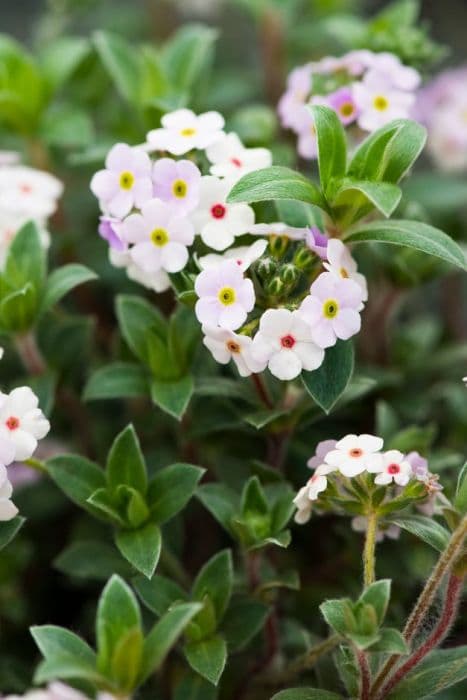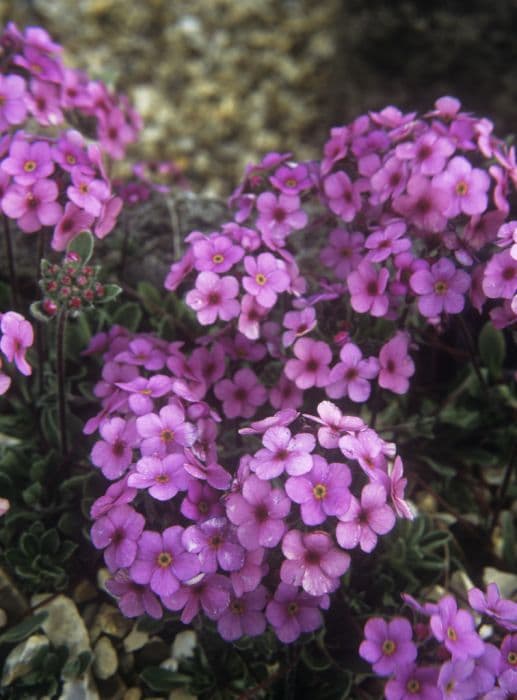Spring Cyclamen Cyclamen repandum subsp. repandum

ABOUT
Cyclamen repandum subsp. repandum, commonly known as Eastern Sowbread, is a perennial plant characterized by its attractive and distinctive features. The plant has heart-shaped leaves that display a variety of patterns, typically with a dark green color and often accented with silver marbling or veining, which adds to its ornamental appeal. The flowers of the Eastern Sowbread are particularly charming and are borne on slender stems above the foliage, elegantly nodding their heads. The blooms range in color, usually found in shades of pink or white, with a delicate and graceful appearance. Each flower has a reflexed petal structure, which gives them a swept-back look adding to their overall whimsy and allure. The center of the flowers usually features a mouth with a contrasting color, making them stand out even more against the foliage. During its blooming season, the Eastern Sowbread puts on a lavish display which is eye-catching in a woodland setting or in a shaded garden. Its leaves and flowers both contribute to the decorative quality of the plant, making it a lovely choice for those who appreciate subtle yet sophisticated beauty in their garden spaces.
About this plant
 Names
NamesFamily
Primulaceae
Synonyms
Spring Cyclamen, Ivy-Leaved Cyclamen, Eastern Sowbread
Common names
Cyclamen vernale Mill., Cyclamen rhodium subsp. vividum Yild., Cyclamen elegans Pančić, Cyclamen repandum Sibth. & Sm.
 Toxicity
ToxicityTo humans
Cyclamen is generally considered toxic to humans if ingested. It contains saponins, which can cause symptoms such as stomach pain, nausea, vomiting, and diarrhea when eaten. In some cases, ingestion might lead to more severe symptoms such as heart rhythm disorders, seizures, and even death, but these extreme reactions are uncommon. The most dangerous parts are the root tubers, so care should be taken to avoid accidental consumption, especially by children who might be attracted to the plant's bright flowers.
To pets
Cyclamen, also toxic to pets, can cause symptoms similar to those in humans if ingested. Pets, particularly dogs and cats, may experience vomiting, diarrhea, increased salivation, and a loss of appetite. In severe cases, consumption of the plant, particularly the tubers, can lead to heart rhythm abnormalities, seizures, and potentially death. Pet owners should ensure that cyclamen plants are kept out of reach to prevent accidental ingestion.
 Characteristics
CharacteristicsLife cycle
Perennials
Foliage type
Deciduous
Color of leaves
Variegated
Flower color
Pink
Height
0.5 feet (15 cm)
Spread
1 feet (30 cm)
Plant type
Bulb
Hardiness zones
9
Native area
Mediterranean
Benefits
 General Benefits
General Benefits- Aesthetic Appeal: Cyclamen repandum, also known as the spring cyclamen, blooms with attractive and delicate flowers that enhance the visual beauty of gardens and indoor spaces.
- Pollinator Attraction: The flowers of the spring cyclamen attract pollinators such as bees and butterflies, contributing to the health of the local ecosystem.
- Low Maintenance: Spring cyclamen is considered easy to care for, requiring minimal attention once established in appropriate conditions.
- Seasonal Interest: With its spring blooming season, Cyclamen repandum adds color and interest to gardens at a time when many other plants may not be in flower.
- Compact Growth: Its compact size makes it suitable for small gardens, rockeries, or as a houseplant where space is limited.
- Diversity in Landscaping: Cyclamen repandum offers variety in landscaping due to its unique foliage and flower forms which can be different from other common garden plants.
 Medical Properties
Medical PropertiesThis plant is not used for medical purposes.
 Air-purifying Qualities
Air-purifying QualitiesThis plant is not specifically known for air purifying qualities.
 Other Uses
Other Uses- Cyclamen repandum, commonly known as spring cyclamen, can be used in perfume-making thanks to its delicate floral scent, often inspiring fragrances with a fresh, spring-like aroma.
- The tubers of the spring cyclamen can serve as a source of starch for emergency food situations, though they require proper treatment to remove toxins.
- Spring cyclamen flowers can be crystallized and used as edible decorations on cakes and pastries, adding a touch of elegance.
- The vibrant flowers of spring cyclamen can be used in the art of flower pressing, creating beautiful and natural decorative pieces.
- Spring cyclamen's interesting leaf patterns make it a great candidate for botanical illustration, contributing to art and education.
- Dried petals of the spring cyclamen may be utilized in potpourri mixtures, contributing to a pleasant aroma in living spaces.
- Insect-repelling properties of the spring cyclamen foliage have been reported, though they should be used with caution as the plant can be toxic.
- The spring cyclamen is sometimes used in symbolic gestures in floristry, representing departure and goodbye, fitting for farewell gifts and endings.
- Spring cyclamen can be used in garden design to attract pollinators such as bees, butterflies, and hummingbirds due to their nectar-rich flowers.
- The plant's ability to grow in shady areas makes it suitable for underplanting in woodland gardens, providing early spring color before the canopy closes.
Interesting Facts
 Feng Shui
Feng ShuiCyclamen is not used in Feng Shui practice.
 Zodiac Sign Compitability
Zodiac Sign CompitabilityCyclamen is not used in astrology practice.
 Plant Symbolism
Plant Symbolism- Pure Love: Cyclamen repandum subsp. repandum, commonly known as "Cyclamen," is often symbolic of sincere, tender love due to its delicate and endearing flowers.
- Giving: The generous blooming of Cyclamen represents giving without thought of reward, embodying a selfless nature.
- Goodbye: In the language of flowers, Cyclamen is sometimes used to convey a resignation or a farewell, perhaps due to the way the flowers droop and then seed themselves as they fade.
- Fertility and Birth: The bulbous growth form of Cyclamen is reminiscent of fertility and has been believed to symbolize birth and motherhood.
- Devotion: The cyclamen's perennial nature, reblooming each year, stands for lasting devotion and fidelity.
 Water
WaterEastern cyclamen should be watered when the top inch of soil feels dry to the touch; this will typically be about once a week, but can vary depending on environmental conditions. Water the plant with cool water, using a watering can with a narrow spout to direct water towards the root zone and avoiding wetting the foliage. Each watering session should provide sufficient moisture to soak the soil without leaving the plant standing in water. You may need to adjust the frequency during the active growth period, providing about 8-16 ounces of water weekly, depending on the size of the pot and the plant's requirements.
 Light
LightEastern cyclamen thrives in bright, indirect light, such as that found near an east- or north-facing window. Direct sunlight can scorch the leaves, so it's crucial to protect the plant from harsh rays, especially during the hotter parts of the day. A spot that receives dappled sunlight or is shaded by a sheer curtain is ideal for maintaining vibrant foliage and encouraging blooming.
 Temperature
TemperatureEastern cyclamen prefers cooler temperatures, ideally between 50°F and 68°F. They can tolerate temperatures as low as 40°F and as high as 77°F, but sustained temperatures outside this range can stress the plant. During winter rest periods, cooler temperatures are preferable to mimic the natural dormant state of the plant.
 Pruning
PruningEastern cyclamen requires minimal pruning, primarily for removing yellowing or wilted leaves and spent flowers to maintain a tidy appearance and encourage new growth. Pruning should be done after flowering ends, typically using clean scissors to cut the stems near the base. Regular removal of dead material helps prevent fungal diseases and encourages the plant's energy to be directed towards healthy growth.
 Cleaning
CleaningAs needed
 Soil
SoilEastern Sowbread prefers a well-draining, humus-rich soil with a slightly acidic to neutral pH of about 6.5 to 7. The best soil mix can be made with equal parts of potting soil, perlite, and peat or leaf mold to ensure good drainage and moisture retention.
 Repotting
RepottingEastern Sowbread should be repotted once every 1-2 years, ideally when the plant is in its dormant phase after the leaves have died back.
 Humidity & Misting
Humidity & MistingEastern Sowbread thrives in moderate to high humidity levels, ideally between 50-70%, which mimics its natural woodland habitat conditions.
 Suitable locations
Suitable locationsIndoor
Place in bright, indirect light and ensure high humidity.
Outdoor
Plant in dappled shade with well-draining soil.
Hardiness zone
7-9 USDA
 Life cycle
Life cycleCyclamen repandum, commonly known as spring cyclamen, begins its life cycle as a seed, sown typically in autumn, which germinates in a cool and moist environment. After germination, it develops a tuber that grows underground, where it remains dormant through the hot and dry summer months. In late winter to early spring, leaves emerge from the tuber, and the plant goes through a vegetative growth phase, developing heart-shaped, marbled leaves. Following the appearance of leaves, the plant produces delicate, scented flowers ranging from white to pink with a magenta base, usually blooming from early spring to late spring. After pollination, the flowers give way to seed capsules that ripen over time, eventually splitting open to release the seeds, completing the reproductive phase. The above-ground portion of the plant dies back after the seeds are dispersed, and the cycle recommences from the tuber after the summer dormancy.
 Propogation
PropogationPropogation time
Spring-Early Summer
Cyclamen repandum, commonly known as Eastern Cyclamen, is typically propagated through seed sowing. The optimal time to sow Cyclamen repandum seeds is in late summer to early fall, after they have ripened. The seeds need to be sown on the surface of a well-drained, open compost mix made rich with leaf mold. It is crucial to not cover the seeds deeply with soil but to lightly press them into the compost. After sowing, the compost needs to be kept moist and in a shaded place for germination to occur, which can take from several weeks to a few months. Once seedlings emerge and grow large enough to handle, they can be potted on into individual pots. It's important to provide a cool but frost-free environment over the winter for the young plants to develop properly.









